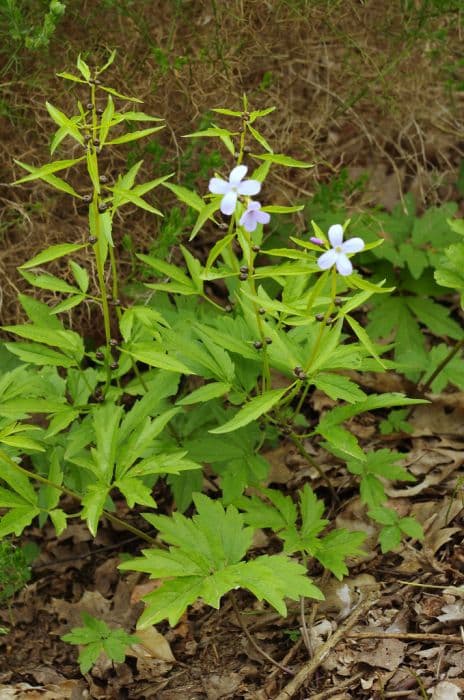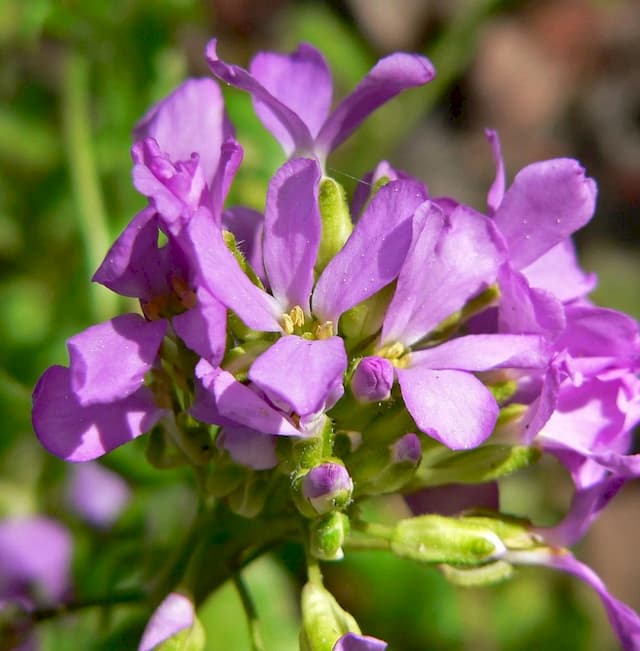Evening Scented Stock Matthiola longipetala subsp. bicornis

ABOUT
The plant commonly known as evening stock is characterized by its delightful, fragrant flowers that typically bloom during the evening or at night. These flowers have a distinctive appearance with narrow petals that come in various shades such as white, pink, lavender, or purple, often creating a soft and appealing palette in gardens. The blooms can be single or double petaled, adding to the variety in its presentation. The leaves of the evening stock are generally lance-shaped or oblong, with a slightly greyish-green hue that gives the foliage a dusty appearance. These leaves are arranged alternately along the stems, creating a somewhat sparse but still aesthetically pleasing foliage backdrop for the flowers. The stems of evening stock are erect and branching. They tend to have a somewhat bushy growth habit, which allows the clusters of fragrant blossoms to be displayed prominently. The texture of the stems and foliage is another distinguishing feature; they may feel slightly rough or hairy, which is typical for plants in their family. Overall, the evening stock is appreciated for its aromatic qualities and its ability to provide a sensorial experience in the garden, especially in the late hours of the day when many other flowers have closed for the night. Its colorful and scented blooms create an alluring atmosphere, making it a favorite among night-time garden enthusiasts and those who enjoy evening strolls through their plantings.
About this plant
 Names
NamesFamily
Brassicaceae.
Synonyms
Evening Scented Stock, Night-scented Stock, Perfume Plant.
Common names
Cheiranthus bicornis, Cheiranthus longipetalus, Matthiola bicornis, Matthiola longipetala.
 Toxicity
ToxicityTo humans
Evening Stock is generally not considered toxic to humans. However, it is always advisable to avoid ingesting any part of ornamental plants due to the potential for individual allergies or unexpected reactions. If large quantities were consumed or if an individual had a specific sensitivity, stomach upset or other digestive disturbances might occur.
To pets
Evening Stock is not typically listed as a toxic plant to pets. However, as with humans, it is wise to prevent pets from eating ornamental plants. Some animals may have a sensitivity to the plant that could result in mild gastrointestinal upset if ingested in significant amounts.
 Characteristics
CharacteristicsLife cycle
Biennials
Foliage type
Deciduous
Color of leaves
Green
Flower color
Varies
Height
1-2 feet (30-60 cm)
Spread
1 feet (30 cm)
Plant type
Herb
Hardiness zones
7
Native area
Mediterranean
Benefits
 General Benefits
General Benefits- Aesthetic Appeal: Matthiola longipetala subsp. bicornis, commonly known as evening stock, produces small and pleasant-smelling flowers that enhance the beauty of gardens and landscapes.
- Fragrance: The flowers of evening stock release a strong and sweet scent in the evening, which can create a delightful atmosphere in outdoor living areas.
- Pollinator Attraction: Evening stock can attract bees, butterflies, and other pollinators to the garden, which is beneficial for the pollination of other plants and the overall health of the garden ecosystem.
- Easy to Grow: Evening stock is known for being easy to cultivate, making it suitable for both experienced and novice gardeners.
- Drought Resistance: Once established, evening stock has good drought tolerance, reducing the need for frequent watering and making it suitable for dry or xeriscape gardens.
- Edging and Borders: Due to its compact growth habit, evening stock is often used for creating visually appealing edges and borders in flower beds and walkways.
- Cottage Gardens: Its traditional cottage appeal makes evening stock a common choice for cottage garden designs, where it can be planted alongside other classic cottage garden plants.
- Container Gardening: Evening stock can thrive in pots and containers, allowing those with limited space or without a traditional garden to still enjoy its benefits.
- Variety of Colors: The plant offers a mixed color palette ranging from white to pink to purple, providing versatility in garden color schemes.
- Night Gardens: Evening stock is particularly suited for night gardens where its fragrance can be appreciated during the evening hours when people are more likely to be enjoying their garden spaces.
 Medical Properties
Medical PropertiesThis plant is not used for medical purposes.
 Air-purifying Qualities
Air-purifying QualitiesThis plant is not specifically known for air purifying qualities.
 Other Uses
Other Uses- Decorative dried flowers: Even after they've dried out, the flowers of night scented stock can be used for their shape and structure in decorative arrangements or crafts.
- Natural dye source: The petals of the night scented stock could potentially be used to produce natural dyes for clothing or artwork.
- Education and research: Night scented stock can be used as a subject for botanical studies and education due to its distinctive characteristics.
- Garden fragrance layering: Night scented stock emits a strong fragrance at night, making it a great choice for gardeners who want to layer scents and create a nighttime aromatic garden.
- Companion planting: It could be planted alongside vegetables or other plants as a companion plant that can attract beneficial insects for pollination.
- Landscape design: Night scented stock can be used in landscape design to add height and texture to flower beds and borders.
- Flower pressing: The flowers of this plant can be pressed and used in creating floral artwork, bookmarks, or other keepsakes.
- Special events: Because of their strong evening fragrance, they might be used to add a scent dimension to evening events and weddings held outdoors.
- Floral photography: Its unique look and evening fragrance can add another layer of interest to nighttime floral photography.
- Culinary decoration: While not typically used for consumption, the flowers could adorn food dishes for visual appeal, but should be removed before eating.
Interesting Facts
 Feng Shui
Feng ShuiThe Evening Stock is not used in Feng Shui practice.
 Zodiac Sign Compitability
Zodiac Sign CompitabilityThe Evening Stock is not used in astrology practice.
 Plant Symbolism
Plant Symbolism- Enduring Beauty: Matthiola longipetala subsp. bicornis, commonly known as night-scented stock, represents enduring beauty due to its delightful fragrance that lingers even after the sun has set, symbolizing lasting attractiveness that endures beyond the superficial.
- Reminiscence: The strong, nostalgic scent of night-scented stock evokes memories and is often associated with reminiscing about past experiences and loved ones.
- Happy Life: With its vibrant blooms, night-scented stock is also symbolic of a happy life, expressing joy and satisfaction in the present moment.
- Comfort and Consolation: The plant's ability to spread its fragrance in the evening can symbolize offering comfort and consolation in times of darkness or sadness.
- Affection and Bonding: Giving night-scented stock to someone can symbolize the forming of an affectionate bond, or the desire to grow closer, as the scent brings people together.
 Water
WaterEvening scented stock, Matthiola longipetala subsp. bicornis, prefers consistent moisture, so it should be watered deeply once or twice a week, depending on weather conditions and soil drainage. Provide about one to two inches of water at each session, ensuring the soil is moist but not waterlogged. During hotter and drier spells, increase watering frequency to maintain soil moisture. Allow the top inch of soil to dry out before watering again to prevent overwatering, which can lead to root rot.
 Light
LightEvening scented stock thrives in full sun to partial shade. The best spot for this plant is one where it can receive at least six hours of sunlight daily. While it can tolerate some light shade, too much shade can reduce blooming and lead to leggy growth.
 Temperature
TemperatureEvening scented stock does well in a range of temperatures but prefers cooler conditions and can be damaged by extreme heat. It can survive temperatures as low as 40 degrees Fahrenheit and as high as 75 degrees Fahrenheit, but the ideal temperature range for this plant is between 55 and 65 degrees Fahrenheit.
 Pruning
PruningEvening scented stock should be pruned to remove spent flowers and to promote bushier growth. Prune lightly throughout the blooming season to encourage more blooms. The best time to prune is after a flush of flowers has finished, cutting back the stems by one-third to stimulate new growth.
 Cleaning
CleaningAs needed
 Soil
SoilNight-scented stock thrives in well-draining soil with a pH between 6.0 and 7.0; a mixture of loamy soil, compost, and perlite or sand is ideal for maintaining good drainage and fertility.
 Repotting
RepottingNight-scented stock should be repotted every year or two to refresh the soil and accommodate growth, ideally in the spring before the onset of the growing season.
 Humidity & Misting
Humidity & MistingNight-scented stock prefers moderate humidity levels; it does not require high humidity and can tolerate the drier conditions commonly found in home environments.
 Suitable locations
Suitable locationsIndoor
Ensure bright light, cool temps, and well-draining soil for indoor night-scented stock.
Outdoor
Plant in full sun to partial shade with good soil drainage for outdoor night-scented stock.
Hardiness zone
7-10 USDA
 Life cycle
Life cycleMatthiola longipetala subsp. bicornis, commonly known as evening-scented stock, begins its life cycle as a seed, which, when sown in fertile, well-draining soil and given adequate warmth and moisture, germinates. The germinated seed develops into a seedling, characterized by a pair of initial leaves (cotyledons), followed by the true leaves that are specific to the species. As the plant grows, it enters the vegetative stage, where it develops a robust root system and a strong stem, alongside a proliferation of foliage. With appropriate light and temperature, the plant then transitions to the flowering stage, where it produces fragrant flowers that are typically pink, white, or lilac in color, mainly during the evening hours, hence its common name. Following pollination, which can be facilitated by nocturnal insects attracted by the scent, the plant sets seeds within capsules. At the end of the growing season, the plant completes its life cycle by dispersing seeds, either by self-sowing or with external assistance, ensuring a new generation of plants for the next season.
 Propogation
PropogationPropogation time
Spring-Early Summer
Propogation: Evening scented stock, or Matthiola longipetala subsp. bicornis, is most commonly propagated by seed. The best time to sow the seeds is in early spring, typically in March or April, when the risk of frost has passed. To propagate by seed, one should sprinkle the seeds onto a well-drained seed starting mix and lightly cover them with a thin layer of soil, aiming for a depth of about 1/8 inch (approximately 3 mm). The seeds need light to germinate, so it's important to not bury them too deeply. Keep the soil moist but not waterlogged, and place the seed tray in a warm, light position, but not in direct sunlight. Germination usually occurs within 10 to 15 days. After the seedlings have developed their first set of true leaves, they can be transplanted to individual pots or placed directly in the garden at a spacing of about 8 to 12 inches (20 to 30 centimeters) apart.






![Aubrieta [Axcent Lilac]](/_next/image?url=https%3A%2F%2Fplants-admin.emdemapps.com%2Fimages%2Fplants%2F%2Fimages%2F604b5e2430fac.png&w=640&q=75)

